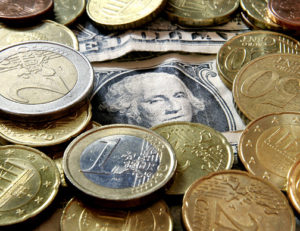 Yesterdays trade saw EUR/USD within the range of 1.1446-1.1299. The pair tumbled 1.05% for the day to close at 1.1324 after it settled last week 2.2% higher, a fifth straight weekly increase.
Yesterdays trade saw EUR/USD within the range of 1.1446-1.1299. The pair tumbled 1.05% for the day to close at 1.1324 after it settled last week 2.2% higher, a fifth straight weekly increase.
At 07:01 GMT today EUR/USD was down 0.41% for the day to trade at 1.1269. The cross held in a daily range of 1.1285 – 1.1326.
Fundamentals
Eurozone
The gauge of economic sentiment in Germany probably fell to a reading of 49.0 in May, according to the median forecast by experts, from 53.3 in April.
The ZEW (Zentrum für Europäische Wirtschaftsforschung) economic expectations index is published on a monthly basis. The study encompasses up to 350 financial and economic analysts and reflects the difference between the share of analysts that are optimistic, and those that are pessimistic about the expected economic development in Germany over the next six months. A positive value indicates that the proportion of optimists is larger than that of pessimists. A ZEW reading of -100 suggests that all analysts are pessimistic about the current developments and expect economic conditions to deteriorate. A ZEW reading of 100 implies that all analysts are optimistic about the current situation and expect conditions to improve. A ZEW reading of 0 indicates neutrality.
The index of current assessment in Germany probably eased as well, expected to drop to 68.0 from 70.2 in April.
The ZEW Economic Sentiment index for the entire Eurozone probably rose to 65.6 from 64.8 in April. If confirmed, this would be the seventh consecutive monthly increase.
In case the gauge of economic sentiment exceeded expectations, this would certainly have a positive impact on the common currency. The official data is scheduled to be released at 09:00 GMT.
Inflation
The final annualized consumer inflation in the Eurozone for April, evaluated in accordance with Eurostat’s harmonized methodology, probably confirmed the preliminary rate of 0.0% which was reported on April 30th. If so, this would end four straight months of deflation, with food prices rising, while energy costs fell at a slower pace. In March, the final HICP reading pointed to annual inflation rate of -0.1%, which matched the preliminary estimate.
In monthly terms, the consumer price index likely rose 0.2% last month, compared to a 1.1% jump in March.
The index shows the change in price levels of a basket of goods and services from consumer’s perspective and also reflects purchasing trends. The main components of the HICP are food, alcohol and tobacco (accounting for 19% of the total weight), energy (11%), non-energy industrial goods (29%) and services (41%).
The HICP is used to evaluate and compare inflation rates between Member States, according to Art. 121 of the Amsterdam’s Agreement and directives by the European Central Bank (ECB), in order for the latter to achieve price stability and implement monetary policy. The HICP aggregates are calculated as a weighted average of each member state’s HICP components.
In case the HICP fell more than anticipated, thus, further distancing from the 2% inflation objective set by the ECB, this would mount selling pressure on the euro because of the greater possibility of expanding the set of monetary policy measures in order to stimulate economic activity.
The final annualized core CPI probably matched the preliminary core inflation estimate, which was reported at 0.6% on April 30th. This index excludes volatile categories such as food, energy, alcohol and tobacco. Eurostat is scheduled to release the final inflation data at 09:00 GMT.
Trade data
A separate report by the statistics agency might show that the surplus on the euro areas seasonally-adjusted trade balance probably widened to EUR 22.8 billion in March, according to the median forecast by experts, from a surplus figure of EUR 20.3 billion a month earlier. Exports rose 4% year-on-year in February, helped by a weak euro, while imports were flat.
The Eurozones balance of trade produces regular surpluses mainly due to the high export of manufactured goods, such as machinery and vehicles. At the same time, the region is a net importer of energy and raw materials. Member states such as Germany, Italy, France and Netherlands play a key role in total trade.
The trade balance, as an indicator, measures the difference in value between the region’s exported and imported goods and services during the reported period. It reflects the net export of goods and services, or one of the components to form the Gross Domestic Product. Generally, exports reflect economic growth, while imports indicate domestic demand. In case the trade balance surplus narrowed more than anticipated in January, this would certainly have a bearish impact on the euro.
United States
The number of housing starts in the United States probably rose to 1.019 million in April from the seasonally adjusted annual rate of 0.926 million during the prior month. Single-family housing starts rose 4.4% in March to 618 000 while starts of buildings with five units or more dropped 7.1% to 287 000.
Housing Starts represent a gauge to measure residential units, on which construction has already begun, every month. A start in construction is defined as the foundation laying of a building and it encompasses residential housing primarily.
The number of building permits in the country probably increased to 1.060 million last month from a revised annual level of 1.042 million in March.
Building permits are issued in order to allow excavation. An increase in the number of building permits and housing starts usually occurs a few months after mortgage rates in the country have been reduced. Permits are not required in all regions of the United States. Building permits, as an indicator, provide information regarding demand in the US housing market. In case a higher-than-anticipated figure is reported, this will certainly support the US dollar. The Commerce Department will release the official housing data at 12:30 GMT.
Pivot points
According to Binary Tribune’s daily analysis, the pair’s central pivot point stands at 1.1356. In case it penetrates the first resistance level at 1.1414, it will encounter next resistance at 1.1503. If breached, upside movement may attempt to advance to 1.1561.
If the cross drops below its S1 level at 1.1267, it will next see support at 1.1209. If the second key support zone is breached, downward movement may extend to 1.1120.
In weekly terms, the central pivot point is at 1.1350. The three key resistance levels are as follows: R1 – 1.1570, R2 – 1.1687, R3 – 1.1907. The three key support levels are: S1 – 1.1233, S2 – 1.1013, S3 – 1.0896.





